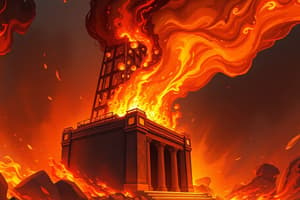Podcast
Questions and Answers
What triggers a backdraft according to IFSTA?
What triggers a backdraft according to IFSTA?
- Immediate suppression of the fire
- Introduction of oxygen into a smoke-filled environment (correct)
- High pressure buildup from flammable vapors
- Cooling of heated gases
How does the definition of an explosion differ from the rapid burning of heated gases?
How does the definition of an explosion differ from the rapid burning of heated gases?
- An explosion involves a sudden chemical transformation producing heat and gases. (correct)
- Rapid burning does not involve the production of large quantities of gases.
- An explosion is caused by a slow combustion reaction.
- Rapid burning is primarily a physical reaction rather than a chemical one.
What physical behavior of smoke is noted prior to a backdraft explosion?
What physical behavior of smoke is noted prior to a backdraft explosion?
- Smoke dissipates quickly
- Smoke is pushed out under pressure and changes direction (correct)
- Smoke suddenly ignites spontaneously
- Smoke remains stationary
What significant risk is associated with opening a building during a fire without proper procedures?
What significant risk is associated with opening a building during a fire without proper procedures?
Which of the following gases is typically produced in an explosive reaction?
Which of the following gases is typically produced in an explosive reaction?
In fire dynamics, what does the term 'heat recovery' refer to?
In fire dynamics, what does the term 'heat recovery' refer to?
What condition is necessary for a material to undergo an explosion?
What condition is necessary for a material to undergo an explosion?
What is the primary danger of a fire suffering from backdraft conditions?
What is the primary danger of a fire suffering from backdraft conditions?
What phenomenon occurs when there is a lack of oxygen during the free burning stage?
What phenomenon occurs when there is a lack of oxygen during the free burning stage?
Which condition does NOT indicate a potential backdraft situation?
Which condition does NOT indicate a potential backdraft situation?
What happens to unburned carbon particles without sufficient oxygen?
What happens to unburned carbon particles without sufficient oxygen?
Which of the following is NOT a necessary element for backdrafts to occur?
Which of the following is NOT a necessary element for backdrafts to occur?
What is the outcome of the heat during the free burning stage if oxygen is not replenished?
What is the outcome of the heat during the free burning stage if oxygen is not replenished?
Which indicator suggests that excessive heat may be present in a building?
Which indicator suggests that excessive heat may be present in a building?
Flashcards are hidden until you start studying
Study Notes
Backdraft Overview
- A backdraft is an explosion or rapid combustion of heated gases due to the introduction of oxygen into a smoke-filled environment.
- Occurs when the Fire Department opens a building without proper ventilation procedures, causing a potentially violent explosion.
Oxygen Depletion and Fire Behavior
- Buildings can become oxygen-depleted during a fire, leading to the accumulation of heat and smoke.
- As smoke becomes pressurized, it may appear to change direction before an explosion occurs.
- Careful opening of areas is crucial to vent heat without introducing excess oxygen near the fire base.
Defining Explosion vs. Rapid Burning
- An explosion is characterized by a sudden, rapid chemical transformation releasing large quantities of heat and gases.
- Gases produced often include carbon monoxide, carbon dioxide, nitrogen, steam, and oxygen.
- The rapid expansion of these gases creates high pressure; the speed of expansion determines explosion classification.
Conditions for Backdraft Development
- Backdrafts result from flammable vapors from a smoldering fire stage, elevated temperature in confined areas, and lack of oxygen.
- Insufficient oxygen leads to incomplete combustion, increasing carbon monoxide and smoke levels.
- Unburned carbon particles and flammable compounds remain dangerously volatile and can combust instantly with added oxygen.
Warning Signs of Backdraft
- Presence of smoke under pressure.
- Black smoke that densifies to a gray or yellow hue.
- Excessive heat and confinement.
- Limited visibility of flames.
- Smoke exiting the building in bursts or puffs.
- Smoke-stained windows indicating heat impact.
- Muffled sounds, such as rattling windows.
- Sudden inward air movement when an opening is made.
Importance of Ventilation
- Proper ventilation minimizes backdraft risks and enhances safety during fire attack operations.
- Training and awareness of backdraft signs are essential for firefighting personnel to prevent dangerous incidents.
Studying That Suits You
Use AI to generate personalized quizzes and flashcards to suit your learning preferences.




